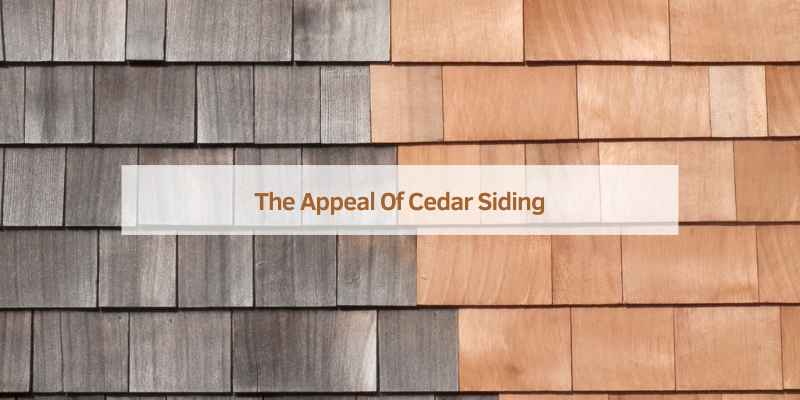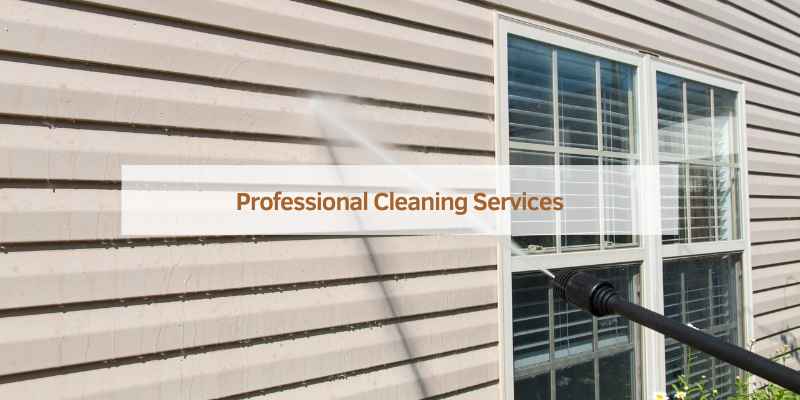The best way to clean cedar siding is to deep clean it before refinishing using oxygen bleach and oxalic acid. Power washing is also an effective method to remove dirt, stains, mold, and mildew from the wood, as long as the siding is not cracked or damaged.
It is important to choose a stain finish that allows for this type of cleaning. Additionally, using a non-toxic oxygen bleach solution can help restore the siding’s original beauty without causing any harm. Remember to remove loose surface dirt before applying the cleaning solution and scrub/rinse the siding from top to bottom for optimal results.
The Appeal Of Cedar Siding
To maintain the appeal of cedar siding, the best way to clean it is by using oxygen bleach and oxalic acid for a deep cleanse. Power washing can also be effective for removing dirt, stains, mold, and mildew, revitalizing the wood’s appearance.
Regular cleaning helps prevent deterioration and discoloration, preserving the beauty of cedar siding for years to come.
Natural Beauty And Durability
Cedar siding offers a unique blend of natural beauty and durability that sets it apart from other siding options. With its warm, rich tones and distinctive grain patterns, cedar brings a touch of elegance and sophistication to any home. The natural beauty of cedar creates a timeless appeal that never goes out of style.
In addition to its aesthetic appeal, cedar siding is known for its exceptional durability. Cedar is naturally resistant to rot, decay, and insect damage, making it a long-lasting choice for exterior siding. This durability ensures that your cedar siding will withstand the test of time and continue to look great for years to come.
Cedar’s Resistance To Elements
One of the key advantages of cedar siding is its remarkable resistance to the elements. Cedar contains natural oils that act as a protective barrier against moisture, UV rays, and temperature fluctuations. This inherent resistance makes cedar siding highly resistant to warping, cracking, and splitting, even in harsh weather conditions.
The natural resistance of cedar to moisture also helps to prevent mold, mildew, and rot from forming on the surface. This means less maintenance and fewer headaches for homeowners, as cedar siding requires minimal upkeep compared to other types of siding materials.
Moreover, cedar’s natural resistance to insects, such as termites and carpenter ants, provides an additional layer of protection for your home. By choosing cedar siding, you can enjoy peace of mind knowing that your home is safeguarded against these destructive pests.
In conclusion, the appeal of cedar siding lies in its natural beauty, durability, and resistance to the elements. Its timeless elegance and ability to withstand harsh weather conditions make it a popular choice for homeowners seeking a high-quality and long-lasting siding option. Whether you are looking to enhance the curb appeal of your home or protect it from the elements, cedar siding is a wise investment that will not disappoint.

Signs Your Cedar Siding Needs Cleaning
Is your cedar siding looking dull and weathered? If you notice mold, mildew, or a buildup of dirt and grime, it’s time to clean your cedar siding. The best way to clean cedar siding is by using a combination of oxygen bleach and oxalic acid to restore its natural beauty and protect it from further damage.
Spotting Mold And Mildew
If you notice dark or discolored patches on your cedar siding, it may indicate the presence of mold and mildew. These fungi not only detract from the appearance of your home but can also cause damage if left untreated.
Identifying Dirt And Grime Accumulation
Another sign that your cedar siding needs cleaning is the visible accumulation of dirt and grime. Over time, dust, pollen, and other debris can build up on the surface, making your siding look dull and dirty.
Preparation Steps
Before starting the cleaning process for your cedar siding, it’s essential to adequately prepare by taking safety precautions and gathering the necessary tools and materials. These preparation steps will ensure that the cleaning process goes smoothly and effectively.
Safety Precautions
- Wear protective clothing, including gloves, goggles, and a mask, to shield yourself from cleaning chemicals and debris.
- Ensure proper ventilation in the work area to prevent the accumulation of fumes from cleaning solutions.
- Avoid working at heights without appropriate safety measures in place to prevent accidents.
Gathering Necessary Tools And Materials
Before starting the cleaning process, gather the following tools and materials:
| Tools | Materials |
|---|---|
|
|
Choosing The Right Cleaning Agents
When it comes to cleaning cedar siding, choosing the right cleaning agents is crucial to ensure effective and safe cleaning. It’s essential to select products that are gentle on the wood while effectively removing dirt, mold, and other stains. Let’s explore the benefits of oxygen bleach and using oxalic acid for stains to understand the most suitable cleaning agents for cedar siding.
Benefits Of Oxygen Bleach
Oxygen bleach offers several advantages when it comes to cleaning cedar siding. It is a gentle yet powerful cleaner that effectively removes mold, mildew, and algae without causing any harm to the wood. This eco-friendly cleaning agent is safe to use and does not produce any harmful fumes, making it ideal for outdoor cleaning.
Moreover, oxygen bleach is biodegradable and does not pose any environmental hazards, ensuring that it’s safe for plants and surrounding vegetation. Its non-toxic nature makes it a preferred choice for homeowners looking for an environmentally friendly cleaning solution for their cedar siding.
Using Oxalic Acid For Stains
When dealing with stubborn stains on cedar siding, oxalic acid can be a highly effective cleaning agent. It works wonders in removing rust stains, water stains, and tannin stains from the wood. Oxalic acid brightens the wood and restores its natural color, making it an excellent choice for revitalizing the appearance of cedar siding.
However, it’s essential to use oxalic acid with caution and follow the manufacturer’s instructions carefully. Proper safety measures should be taken, including wearing protective gear such as gloves and goggles, as oxalic acid can be hazardous if mishandled.
Manual Cleaning Techniques
To achieve the best results when cleaning cedar siding, opt for manual techniques such as using oxygen bleach and oxalic acid for a deep clean. Power washing can also be effective, but ensure the wood is undamaged. This method is quick, economical, and ideal for pre-refinishing preparation.
Soft Brush And Soapy Water Approach
Begin by mixing a solution of mild soap and water in a bucket. Dip a soft-bristled brush into the soapy water and gently scrub the cedar siding in small sections.
Applying Cleaners Effectively
If the siding requires a deeper clean, consider using specialized cedar siding cleaners. Follow the manufacturer’s instructions for dilution and application methods to ensure optimal results.
Power Washing Do’s And Don’ts
To clean cedar siding effectively, use a gentle power washing technique to remove dirt, stains, mold, and mildew. Ensure the wood is in good condition before power washing to avoid damage. For deep cleaning, consider using oxygen bleach and oxalic acid for a thorough restoration.
Power washing is a popular method for cleaning cedar siding, but it’s important to follow some do’s and don’ts to avoid damaging the wood. When considering power washing, it’s important to know when it’s appropriate to use this method and when to avoid it. When to Use Pressure Washing: Pressure washing can be effective for removing dirt, grime, and mildew from cedar siding. However, it should only be used if the wood is not cracked or damaged. If there are any signs of damage, pressure washing can exacerbate the issue and cause further harm to the wood.
Avoiding Damage to Cedar: To avoid damaging cedar siding during power washing, it’s important to use the correct pressure setting and nozzle type. A pressure setting between 500 and 800 PSI is recommended, and a fan nozzle should be used to avoid concentrating the water stream too much. It’s also important to keep the spray at a safe distance from the wood to prevent damage.
Overall, power washing can be an effective way to clean cedar siding, but it should be used with caution. By following these do’s and don’ts, you can ensure that your cedar siding is cleaned effectively and without causing any damage to the wood.
Post-cleaning Care
To properly care for your cedar siding after cleaning, it is recommended to use oxygen bleach and oxalic acid for a deep clean. Choose a stain finish that allows for this type of cleaning method. Power washing is also an effective way to remove dirt, stains, mold, and mildew, but ensure the wood is not damaged before doing so.
Regular cleaning prevents algae and mold growth, preserving the appearance and durability of your cedar siding.
Rinsing And Drying
After cleaning your cedar siding, it’s crucial to thoroughly rinse off the cleaning solution. Use a garden hose or pressure washer to rinse from top to bottom, ensuring all residue is removed. Pay special attention to any areas that may have accumulated cleaner, as leftover residue can cause damage over time. Once rinsed, allow the cedar siding to air dry completely before proceeding with any further maintenance or treatments.
Regular Maintenance Tips
Proper maintenance is essential for preserving the beauty and integrity of your cedar siding. Here are some tips to keep your siding in top condition:
- Inspect the siding regularly for any signs of damage, such as cracks or splits, and address them promptly to prevent further deterioration.
- Keep vegetation trimmed and away from the siding to prevent moisture retention and potential mold growth.
- Apply a protective finish or stain every few years to enhance the wood’s natural beauty and provide additional protection against the elements.
Finishing Touches
After thoroughly cleaning and preparing your cedar siding, it’s time for the finishing touches to protect and enhance its natural beauty. Selecting the right finish and applying stain for longevity are crucial steps in the maintenance of cedar siding.
Selecting The Right Finish
When choosing a finish for your cedar siding, consider using a high-quality semi-transparent or solid-color stain. These finishes provide excellent UV protection and help to repel water, preventing moisture-related issues such as rot and mildew.
It’s important to select a finish that is specifically formulated for cedar and other wood exteriors. Look for products that offer long-term durability and are resistant to fading, cracking, and peeling.
Applying Stain For Longevity
Before applying the stain, ensure that the cedar siding is clean, dry, and free from any dust or debris. Use a high-quality brush or sprayer to apply the stain evenly, working in small sections to avoid overlap marks.
Properly apply the stain according to the manufacturer’s instructions, ensuring complete coverage of the wood surface. Pay special attention to the end grains and joints, as these areas are more susceptible to moisture penetration.
Allow the first coat to dry thoroughly before applying a second coat for enhanced protection. Regular maintenance and reapplication of the stain as needed will help preserve the beauty and integrity of your cedar siding for years to come.
Professional Cleaning Services
Deep cleaning cedar siding is crucial before refinishing it. The best way to clean cedar siding is by using oxygen bleach and oxalic acid. It’s an economical and quick method to remove dirt, stains, mold, and mildew from the wood.
Before power washing, make sure the wood is not damaged.
When To Call The Pros
Cleaning cedar siding can be a tough job, especially if you have a large home or the siding is severely stained or damaged. In such cases, it may be best to call in the professionals. But how do you know when it’s time to seek help?
Evaluating Service Providers
If you decide to hire a professional cleaning service for your cedar siding, it’s important to choose the right provider. Here are some things to consider when evaluating service providers:
- Experience: Look for a company with experience in cleaning cedar siding specifically.
- Equipment: Ask about the equipment they use and ensure that it’s appropriate for cedar siding.
- Reviews: Check online reviews and ask for references to ensure that the company has a good reputation.
- Pricing: Get quotes from multiple providers and compare pricing to ensure that you’re getting a fair deal.
When you find a service provider that meets your requirements, be sure to communicate your expectations clearly and ask any questions you may have before they begin work. With the right provider, you can rest assured that your cedar siding will look its best for years to come.

Frequently Asked Questions
What Is The Best Cleaner For Cedar Siding?
To clean cedar siding effectively, use oxygen bleach and oxalic acid for a deep clean. Choose a stain finish that complements this method for a cost-effective and efficient process.
How Do You Make Cedar Siding Look New Again?
To make cedar siding look new again, you can power wash it to remove dirt, stains, mold, and mildew. However, make sure the wood is not cracked or damaged before doing so. Another option is to deep clean the siding using oxygen bleach and oxalic acid, followed by refinishing it with a stain finish.
This method is economical and relatively quick. Remember to choose a stain finish that allows for this type of cleaning.
Should I Power Wash My Cedar Siding?
Yes, you should power wash your cedar siding. Power washing is an effective method to quickly remove dirt, stains, mold, and mildew from the wood. However, make sure the wood is not cracked or damaged before power washing. Deep cleaning with oxygen bleach and oxalic acid is also recommended before refinishing the siding.
What Is The Best Product To Use On Cedar Siding?
For cedar siding, use oxygen bleach and oxalic acid for deep cleaning. Choose a stain finish compatible with this method for best results.
Conclusion
Cleaning cedar siding can be effectively done using oxygen bleach and oxalic acid. Power washing is another quick option, but ensure the wood isn’t damaged. Choose a stain finish that complements this cleaning method for a cost-effective and efficient process to revitalize your cedar siding.


